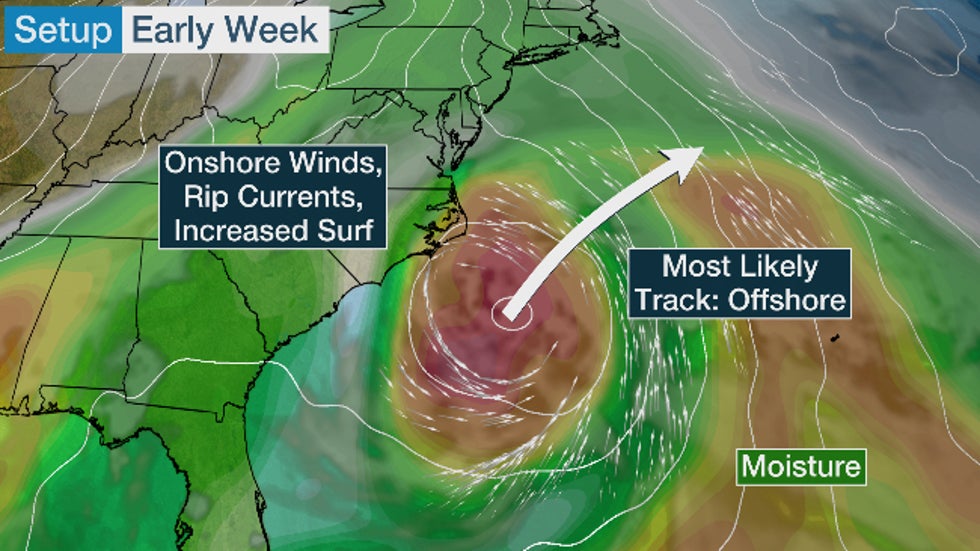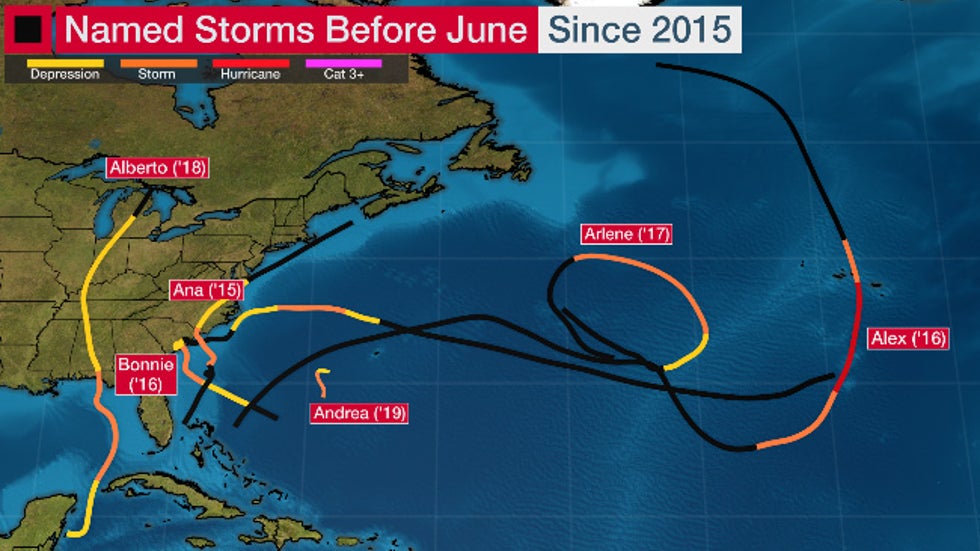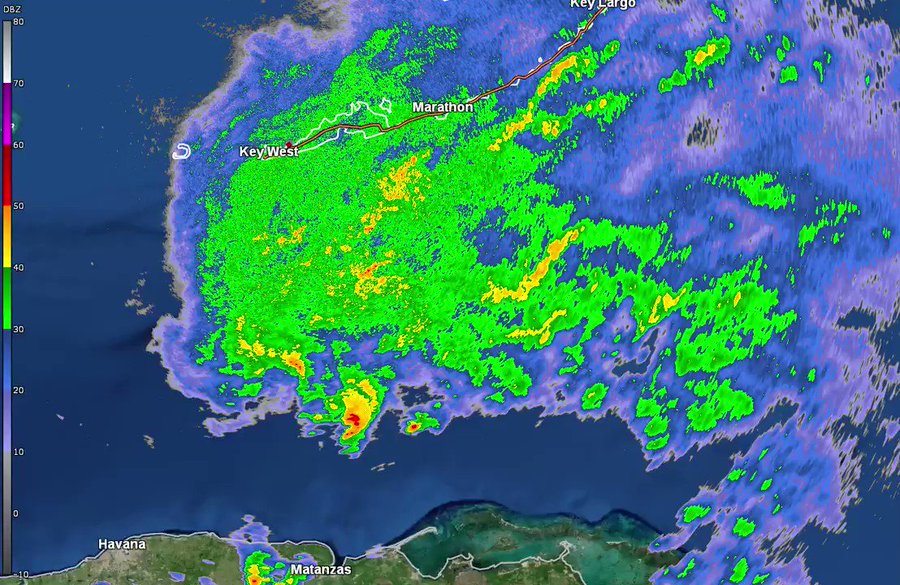The first depression or storm of the 2020 Atlantic hurricane season is expected to form near the Bahamas this weekend, but will only bring a glancing blow of rain to parts of Florida, and high surf to parts of the Southeast coast.
A broad area of low pressure has developed between Cuba and the Florida Keys, and has been producing showers and thunderstorms over the Florida Keys, northern Cuba and over much of the Bahamas.
This system has now been tagged "Invest 90L" by the National Hurricane Center. This tag allows the NHC to run specialized hurricane models, send out the Hurricane Hunters and more.
(MORE: What is an Invest?)
The Middle Keys have already received more than 4 inches of rain since Wednesday, and some street flooding is ongoing. Marathon, Florida has received more than 5 inches of rain already. Wind gusts as high as 45 mph have been reported in the Lower Keys. Hazardous marine conditions have also developed.
An area of light to mdt rain will linger over the Keys thru this afternoon. @NHC_Atlantic has more details on the spin that is emerging on radar about 65 miles south of Key West. A ship reported 11-12 foot seas in the Straits off the Middle Keys arnd Noon. #flwx #flkeys #keywest
The area of storms has developed a general area of spin over the Florida Straits with an occasional lightning strike or two.
Invest 90L is likely to sharpen and acquire characteristics of a subtropical or tropical depression or storm by this weekend as it moves northeastward to the far western Atlantic.

The National Hurricane Center says there is a high chance of a depression or storm developing off the Southeast by Saturday night.
The Hurricane Hunters are scheduled to fly into this developing system on Friday afternoon, and again on Saturday morning, to help figure out what is going on in the lowest levels of the atmosphere, and to discern if the system has become a closed low or not.
Generally, the thinking is that the further west this system is over the weekend, the more likely it will be tropical. In other words, the more likely it will have a condensed wind field and a more symmetric rain shield.
If this system moves more northeastward, it could have more subtropical characteristics.
A subtropical depression or storm exhibits features of both tropical and non-tropical systems. This includes no cold or warm fronts, a broad wind field and at least some thunderstorms removed some distance from the center.
There is more on where this system may track below the forecast impacts.
The National Hurricane Center issues advisories and forecasts for subtropical depressions and storms. They are assigned a number or name, just like a tropical depression or storm. This year's first named storm in the Atlantic basin would be Arthur.
Florida, Bahamas Rain, Waves
Parts of Florida will see bad beach conditions and increasing rain chances through Friday before the subtropical depression or storm organizes.
Clockwise flow around high near Bermuda will bring an east wind flow to Florida's Atlantic coast. Wind gusts as high as 40 mph will be possible from the Florida Keys to Florida's Space Coast through Friday. These winds may also be possible in the northern Bahamas.
Those gusty onshore winds will likely create dangerous rip currents and high surf along much of Florida's eastern coast. The National Weather Service in Miami is warning that there is a high risk of rip currents at South Florida beaches through at least Friday morning. This rip current threat should spread north along Florida's Atlantic beaches through the weekend as the system gains steam.
Parts of South Florida and the Florida Keys will see occasional thunderstorms with locally heavy downpours through Friday, where an inch or more of rain is possible before drier air moves in behind the system later in the weekend. Localized flooding is possible in the Florida Keys.
The heaviest rain from the system, though, is expected to fall over the Bahamas through Friday or Saturday.
 Rainfall Forecast
Rainfall ForecastWhere "It" May Track
Once the depression or storm forms, it is then expected to track toward northeast, with its center remaining off the East Coast, tracking somewhere between Bermuda and the Outer Banks of North Carolina early next week.
It's too soon to determine the exact track, but the low may track close enough to bring some rain and gusty winds to the Outer Banks, possibly the Virginia Tidewater around Monday. After that, the low should turn farther out to sea.

Despite this offshore track, the low is expected to bring at least elevated surf and rip currents to beaches from Florida to Georgia, the Carolinas, Virginia Tidewater, and possibly farther north up the Eastern Seaboard early this weekend into next week.
It could also bring some coastal flooding at high tide in some of these areas.
Check back with us at weather.com for forecast updates as these details come into focus.
Preseason Storms Have Been Common Lately
This potential development off the Southeast coast is another example of how depressions and storms can sometimes form before the hurricane season officially begins on June 1.
Since 2015, at least one named storm has developed before June 1 each hurricane season, some of which had impacts in the United States and elsewhere in the Atlantic Basin.
 Tracks of all Atlantic named storms that have formed before June 1 in each hurricane season from 2015 through 2019. The black segments of tracks denote when each system was either a remnant low-pressure center or an area of low pressure before becoming a depression or storm.
Tracks of all Atlantic named storms that have formed before June 1 in each hurricane season from 2015 through 2019. The black segments of tracks denote when each system was either a remnant low-pressure center or an area of low pressure before becoming a depression or storm.Last May, Subtropical Storm Andrea formed southwest of Bermuda the week before Memorial Day, but only lasted about 24 hours.
In 2018, Tropical Storm Alberto made a Memorial Day landfall along the Florida Panhandle, remained intact and took a strange track into Lower Michigan before losing its tropical characteristics.
Tropical Storm Arlene developed even earlier than Alberto and, in 2017, became only the second April Atlantic tropical storm of record.
Perhaps 2016 was the strangest early start to an Atlantic season in recent memory.
Tropical Storm Bonnie soaked the coast of the Carolinas in late-May 2016. But that was preceded by eastern Atlantic Hurricane Alex, only the second known January Atlantic hurricane. Alex eventually made landfall in the Azores as a tropical storm.
In 2015, Tropical Storm Ana made the second-earliest U.S. landfall of at least a tropical storm on record on Mother's Day weekend along the coast of the Carolinas.
This early start also happened in 2012 (Alberto, then Beryl in May), 2008 (Arthur), 2007 (another Subtropical Storm Andrea) and 2003 (another Ana, this time in April). Beryl nearly became a hurricane before coming ashore near Jacksonville Beach, Florida, on Memorial Day weekend 2012.
Nine of 17 years from 2003 through 2019 had at least one named storm before June 1, and there were a total of 11 out-of-season named storms during that time. The majority of these developed and meandered, or made landfall along the coast from North Carolina to northeastern Florida.
The Weather Company’s primary journalistic mission is to report on breaking weather news, the environment and the importance of science to our lives. This story does not necessarily represent the position of our parent company, IBM.
The Weather Company’s primary journalistic mission is to report on breaking weather news, the environment and the importance of science to our lives. This story does not necessarily represent the position of our parent company, IBM.



No comments:
Post a Comment